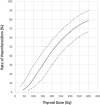Hypothyroidism after radiation exposure: brief narrative review
- PMID: 33034734
- PMCID: PMC7578155
- DOI: 10.1007/s00702-020-02260-5
Hypothyroidism after radiation exposure: brief narrative review
Abstract
The thyroid gland is among the organs at the greatest risk of cancer from ionizing radiation. Epidemiological evidence from survivors of radiation therapy, atomic bombing, and the Chernobyl reactor accident, clearly shows that radiation exposure in childhood can cause thyroid cancer and benign thyroid nodules. Radiation exposure also may induce hypothyroidism and autoimmune reactions against the thyroid, but these effects are less well-documented. The literature includes only a few, methodologically weak animal studies regarding genetic/molecular mechanisms underlying hypothyroidism and thyroid autoimmunity after radiation exposure. Rather, evidence about radiation-induced hypothyroidism and thyroid autoimmunity derives mainly from follow-up studies in patients treated with external beam radiotherapy (EBRT) or iodine-131, and from epidemiological studies in the atomic bombing or nuclear accident survivors. Historically, hypothyroidism after external irradiation of the thyroid in adulthood was considered not to develop below a 10-20 Gy dose threshold. Newer data suggest a 10 Gy threshold after EBRT. By contrast, data from patients after iodine-131 "internal radiation therapy" of Graves´ disease indicate that hypothyroidism rarely occurs below thyroid doses of 50 Gy. Studies in children affected by the Chernobyl accident indicate that the dose threshold for hypothyroidism may be considerably lower, 3-5 Gy, aligning with observations in A-bomb survivors exposed as children. The reasons for these dose differences in radiosensitivity are not fully understood. Other important questions about the development of hypothyroidism after radiation exposure e.g., in utero, about the interaction between autoimmunity and hypofunction, and about the different effects of internal and external irradiation still must be answered.
Keywords: Autoimmune thyroiditis; Diagnostic medical radiation exposure; Hypothyroidism; Other radiation exposure (atomic bombing/nuclear accidents); Therapeutic medical radiation exposure (EBRT/ RAI); Thyroid.
Conflict of interest statement
Nothing to disclose.
Figures





References
-
- Agate L, Mariotti S, Elisei R, Mossa P, Pacini F, Molinaro E, Grasso L, Masserini L, Mokhort T, Vorontsova T, Arynchyn A, Tronko MD, Tsyb A, Feldt-Rasmussen U, Juul A, Pinchera A. Thyroid autoantibodies and thyroid function in subjects exposed to Chernobyl fallout during childhood: evidence for a transient radiation-induced elevation of serum thyroid antibodies without an increase in thyroid autoimmune disease. J Clin Endocrinol Metab. 2008;93:2729–2736. doi: 10.1210/jc.2008-0060. - DOI - PubMed
-
- Akashi M (2016) Presentation 4th Wuerzburg-Moscow Seminar “Radiation Emergency Medicine”, Wuerzburg 16./17.6.2016
Publication types
MeSH terms
Substances
LinkOut - more resources
Full Text Sources
Medical

